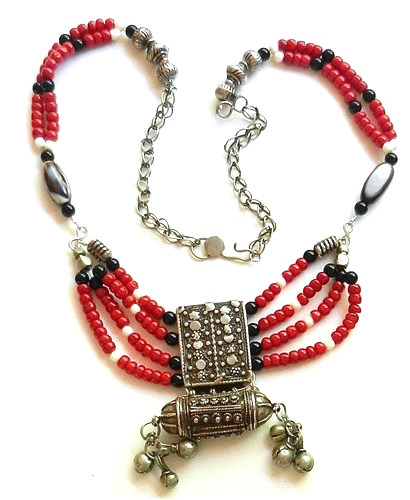In the preceding post, we compared the gilding methods and results of the Turkmen silversmiths and the Yemen silversmiths. Readers have asked me to write a bit more about gilding, so I am happy to show some examples from another tribal tradition among the gilders of silver among the Turkoman tribes.
I rely on the researches of Dieter and Reinhold Schletzer in their book Old Silver Jewellery of the Turkoman. I am not a silversmith, nor do I even know one. But their book is rich in explanations of the physical methods of making the Turkoman jewelry and in interpreting the traditional symbols in the ornamentation.
Those of you familiar with embossing metal will recognize the repousse or chased technique used in the guljaka or collar button (large!) of the Yomud woman in this photo:

The collar button is made by laying out a thin sheet of silver, usually good silver because the Turkmen people were using silver ingots from Europe. That first thin sheet was left plain. Then another sheet of the same material was stretched across a template and pounced with soft hammers or chased with a stylus to create the embossed or repousse patterns. Then it was gilded with a process involving heated mercury and gold. The mercury would vaporize and the gold would combine with the silver sheet of repousse designs.
The designs themselves are traditional and used over and over again in the Yomud ornamental style. They are dotted floral abstractions and strictly numbered sets of jewels and symbols. On this piece there are double sets of 12 floral patterns each. You can count them around the scalloped edge of the round guljaka. The outside set has two embossed flowers; the inside set of 12 has one larger embossed dotted flower between each glass jewel.
Around the central green glass jewel, there are double sets of 12 ancestor symbols, the abstraction of a mountain sheep head, used everywhere in Turkoman jewelry, on their tent hangings, in their carpets, on their outdoor clay brick ovens, on the entry to their homes. The symbols are arranged facing each other with the inside circle of twelve ram heads being smaller than the outer ring of ram head ancestor symbols.
The jewels are made of green, red and blue glass cabochons. The central jewel is molded glass in a kind of baroque faceted pyramid or mountain shape, also significant to the Turkmen people, as they memorialize their origin in the Altai Mountains in their ornamentation.
The patterns that you see in the embossed face of the gilded guljaka would have been pounced into the gilded silver or chased into it with a stylus from a highly polished brass template such as the one in the photo below:
Compare the Yomud traditional ornamentation of their gilded jewelry with the Tekke tradition so well illustrated in the example below. There you will see that the Tekke tribal silversmiths work with cut out patterns in the gilded layer that they then solder to the basic silver layer. You can see the silver layer showing through the cut out designs.
Below is another example of embossed gilded silver jewelry, this time in the Western Yomud tradition, a part of the same tribe that made the guljaka above but occupying a different location in Central Asia. I am including an explanation of the tribal symbols from the Schletzers' book cited above.

This is one of the most beautiful amulets: it is a bearer of legends of the Turkmen. First the fact that in the Yomoud tribe this flat rectangle served the purpose that the cylindrical bozbend served in the Tekke tribe. This shape accommodated a booklet, whereas the bozbend carried a scroll which would not be so many layers of paper as a miniature booklet might have. Added to that, the rectangular or hexagonal tube that is the bozbend did not have the space for surface decoration that the embossed ram head anecestral symbol of the Yomud tribe required. Of course, the Tekke tribe remedied that situation by attaching their bozbend to a tumar - a flat equilateral triangle symbolizing the Altai mountain from which they originated.
The five old turquoise gems have changed color as it does with time and exposure to the elements. This designer, gilder and silversmith in the Western Yomud tribe was not as rigidly traditional in his patterns as he might have been. Five turquoise gems is not divisible by four, as tradition would require. You will note that there are eight dotted floral figures and eight ram heads placed symmetrically around the gems. In that at least the designer was holding to tradition. But he parts with the rules again when he places two repousse flowers and two abstractions of flowers above the prayer box or açar - bag.
A very similar prayer box of the Western Yomud tribe is shown on page 107, plate 39 in Dieter and Reinhold Schletzer's Old Silver Jewellery of the Turkoman. There the açar - bag has three glass gems on the gilded face of the box, while the fourth sits atop the box with four matching symbols of dotted floral abstractions.



























